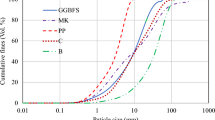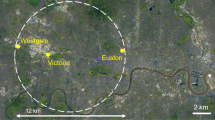Results are provided for a study of porous ceramic materials prepared in the course of chemical and exothermic reactions based on a system containing secondary resources (chamotte scrap, mullite-containing waste, aluminum smelting slag), aluminium phosphate binder, aluminum refractory clay, and various additives. Temperature dependences are established for heat capacity and thermal conductivity in the range 30 – 1000°C for the material obtained. It is shown that the optimum overall aluminum and slag content in a mixture for preparing porous materials is 10 – 20%. It is established that addition of magnesite and chrome-magnesite, and also ammonium dihydrophosphate, makes it possible to control density and strength of the materials obtained.




Similar content being viewed by others
References
G. D. Semchenko, Unmolded Refractories [in Russian], NTU KhPI, Kharkov (2007).
G. D. Semchenko, Refractories for Lining Heating Production Units: Teaching Aid [in Ukrainian], NTU KhPI, Kharkiv (2007).
V. A. Abyzov, “Heat resistance of aerated concrete based on aluminum-magnesium phosphate binder and high-alumina industrial waste,” Diss. Cand. Techn. Sci., 05.23.05, Chelyabinsk (2000).
I. D. Kashcheev, K. K. Strelov, and P. S. Mamykin, Chemical technology of Refractories: Teaching Aid [in Russian], Intermet Inzhiniring, Moscow (2007).
V. A. Kopeikin, A. P. Perova, and I. L. Rashkovan, Materials Based on Metal Phosphates [in Russian], Khimiya, Moscow (1976).
A. I. Khlystov, “Physicochemical bases of determining heat-resistant concrete compositions,” Stroit. Materialy, No. 8, 8 – 9 (1998).
U. Sh. Shayakhmetov, Phosphate Composite Materials and Tests for their Application [in Russian], Staraya Ufa, Ufa (2001).
A. N. Abyzov, “Preparation of heat insulation heat-resistant phosphate materials by self-propagating synthesis,” in: Heat-Resistant Materials and Concretes [in Russian], UralNIIstromproekt, Chelyabinsk (1978).
A. N. Abyzov, “Preparation of porous heat-resistant phosphate materials by self-propagating exothermic syntheses,” Proc. All-Union Meeting “High-temperature chemistry of silicates and oxides,” Nauka, Leningrad (1988).
Ch. G. Pak, “Development and study of heat-resistant aluminum-chromium phosphate aerated concrete,” Diss. Cand. Techn. Sci., Moscow (1987).
V. A. Abyzov, “Cellular heat-resistant materials based on industrial waste,” Building and Education, Issue 4, UGTU, Ekaterinburg (2001).
Ch. G. Pak, V. A. Abyzov, and V. M. Batrashov, “Heat-resistant phosphate cellular materials with variable density,” Vestn. YuUrGU, No. 15, 4 – 5 (2010).
V. A. Abyzov, “Heat-resistant phosphate aerated concrete with addition of refractory fiber waste,” Vestn. YuUrGU, No. 35, 38 – 39 (2011).
M. M. Sychev, Inorganic Adhesives [in Russian], Khimiya, Leningrad (1986).
Author information
Authors and Affiliations
Corresponding author
Additional information
Translated from Novye Ogneupory, No. 9, pp. 27 – 32, September, 2016.
Rights and permissions
About this article
Cite this article
Podbolotov, K.B. Refractory Porous Materials Based on Secondary Resources and Phosphate Compounds. Refract Ind Ceram 57, 484–489 (2017). https://doi.org/10.1007/s11148-017-0009-z
Received:
Published:
Issue Date:
DOI: https://doi.org/10.1007/s11148-017-0009-z




